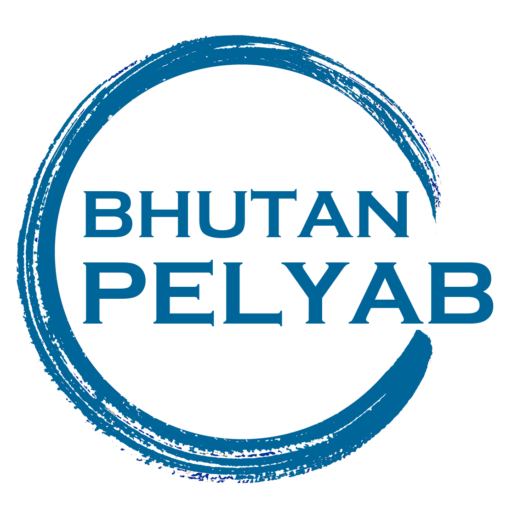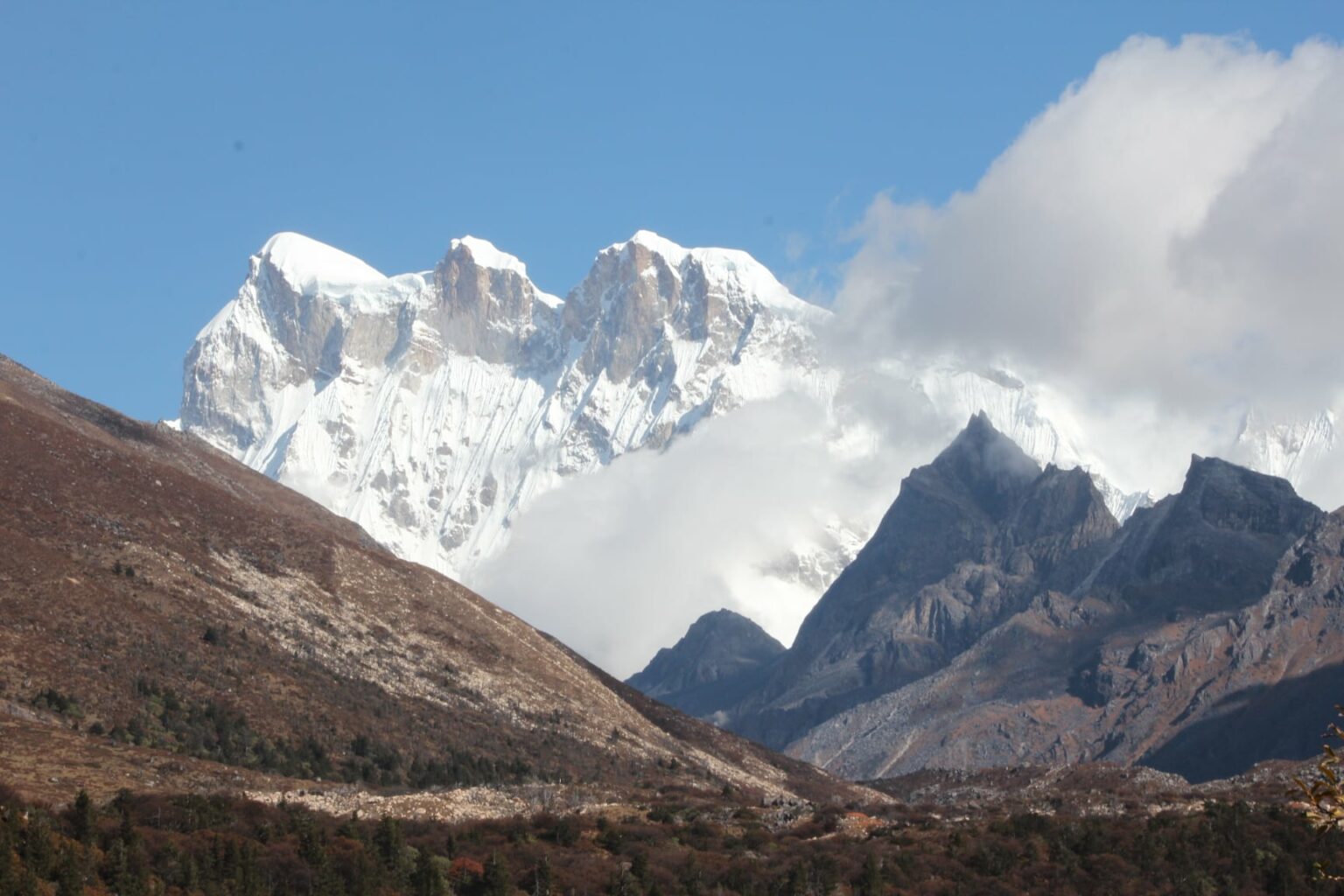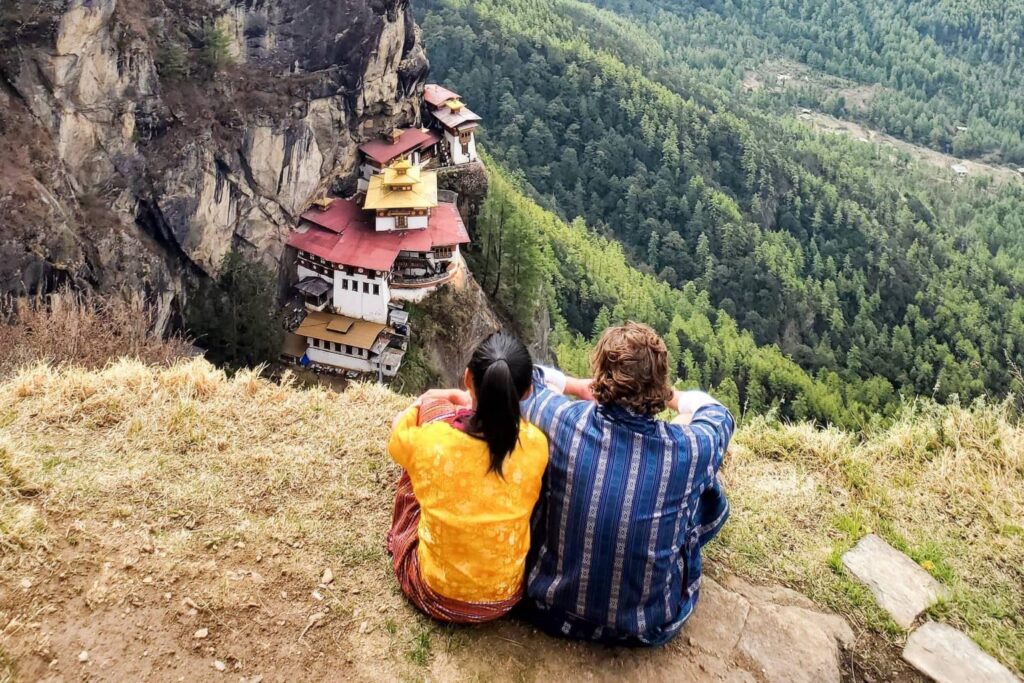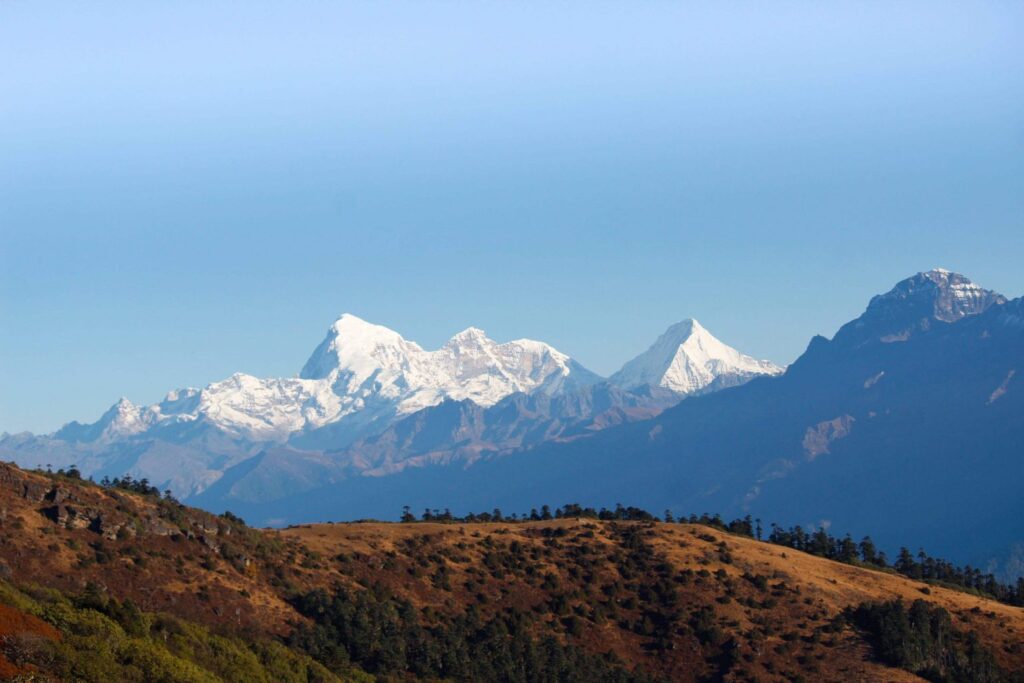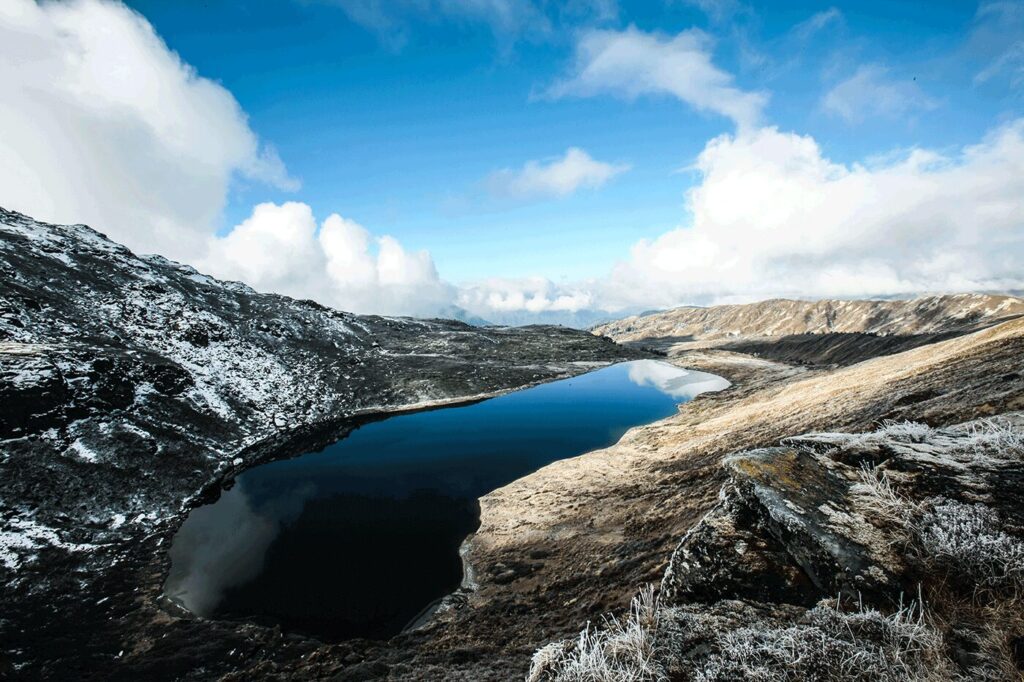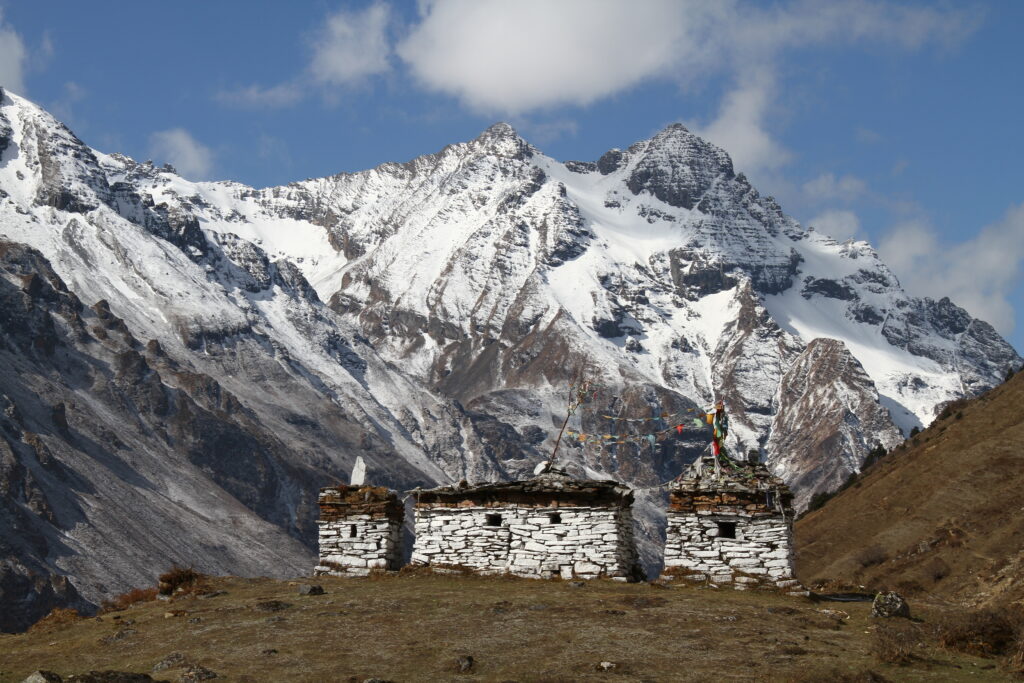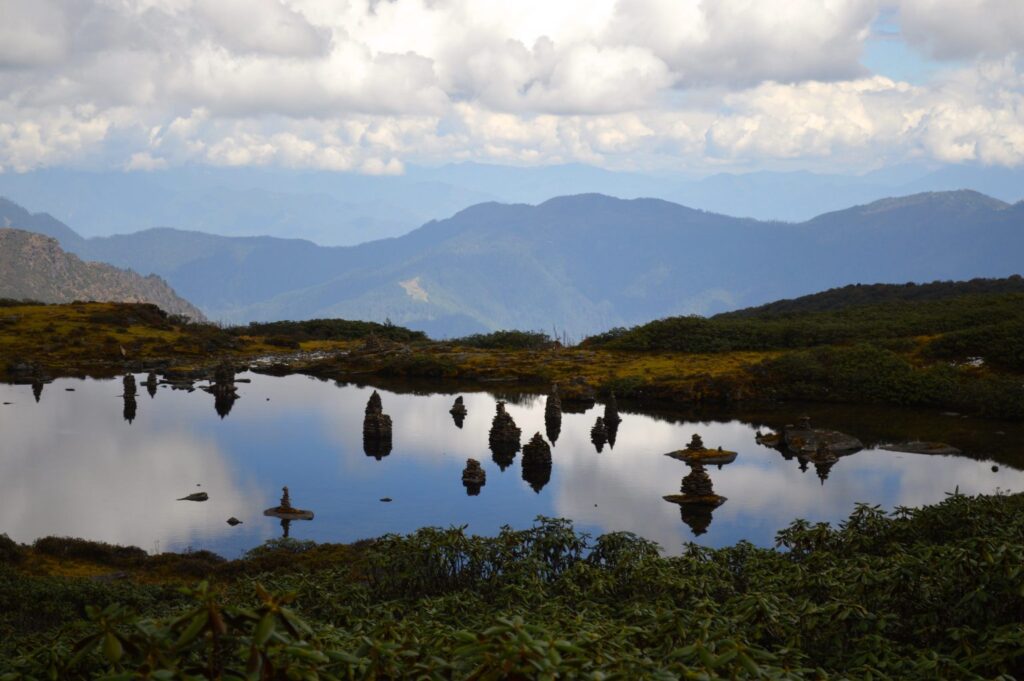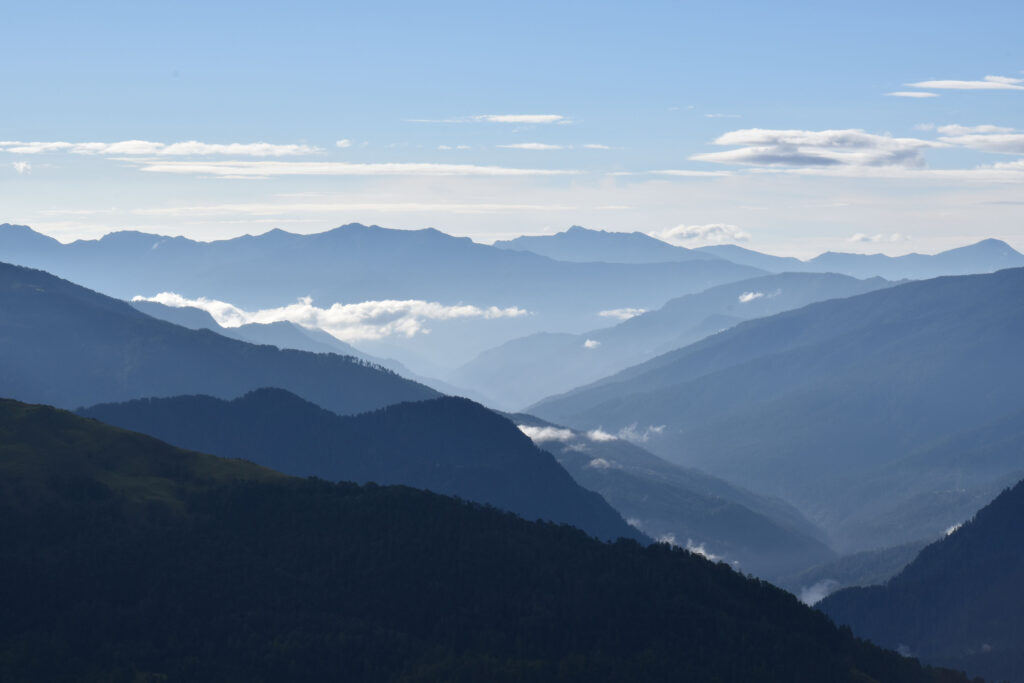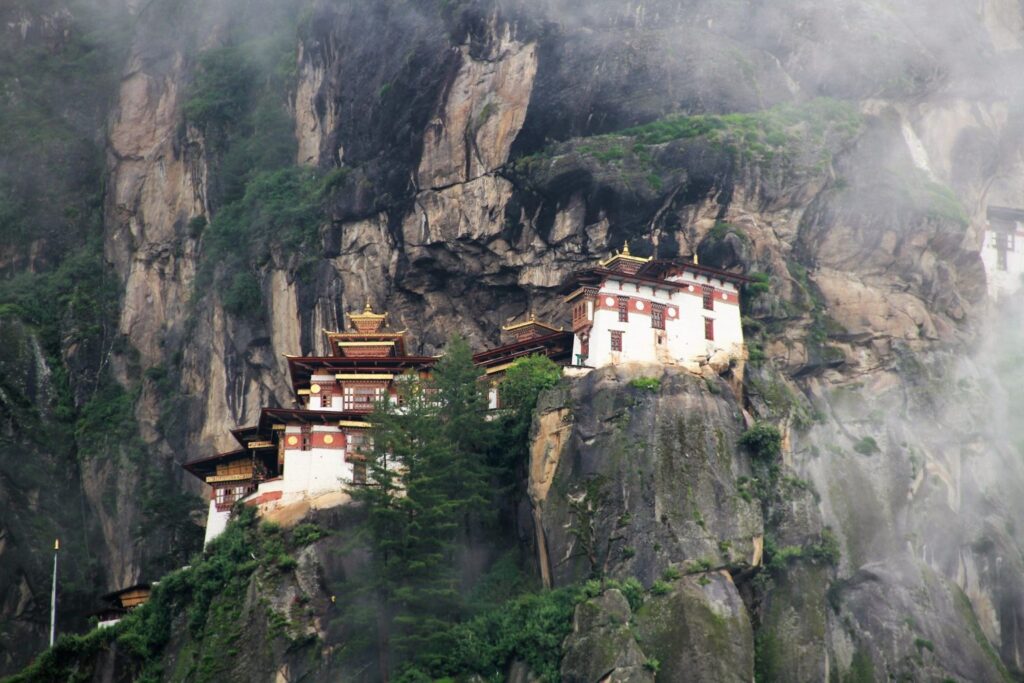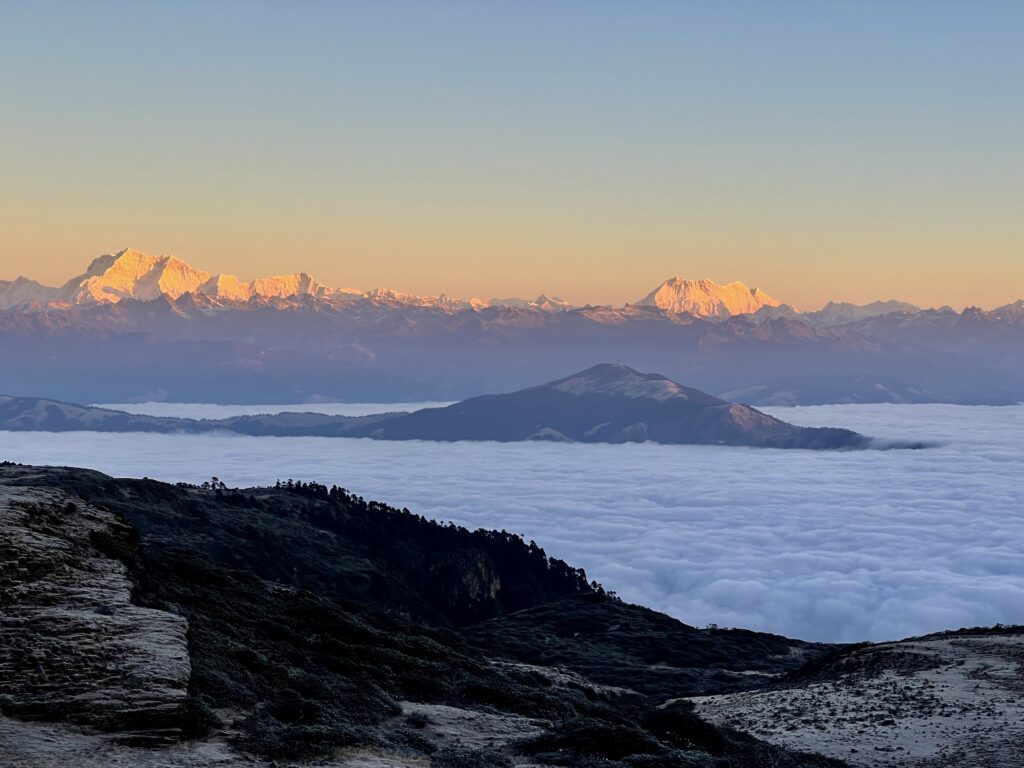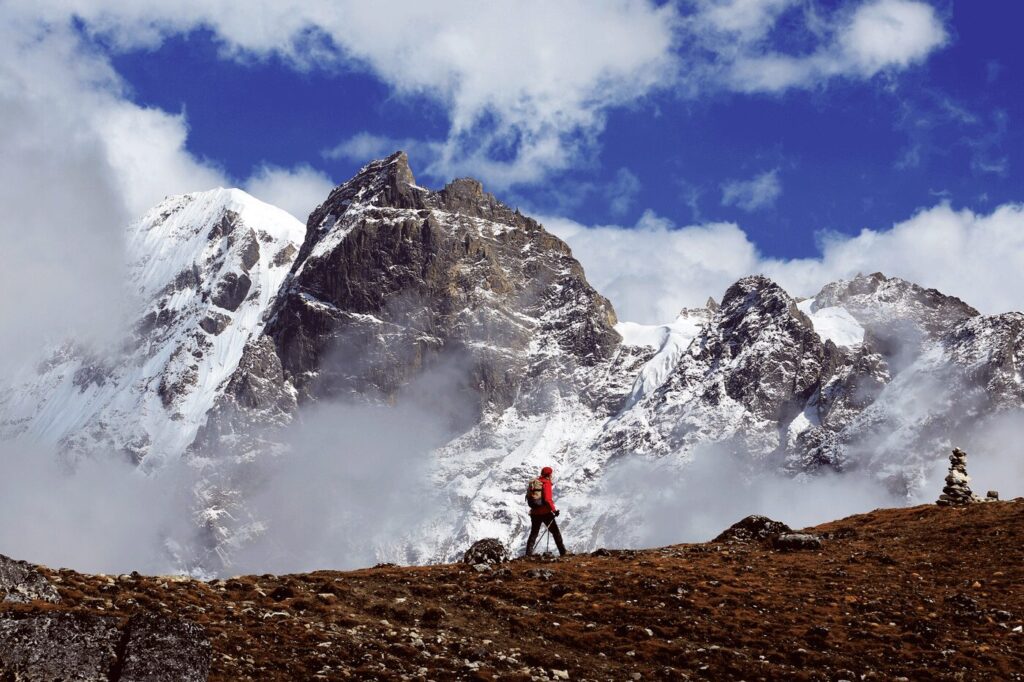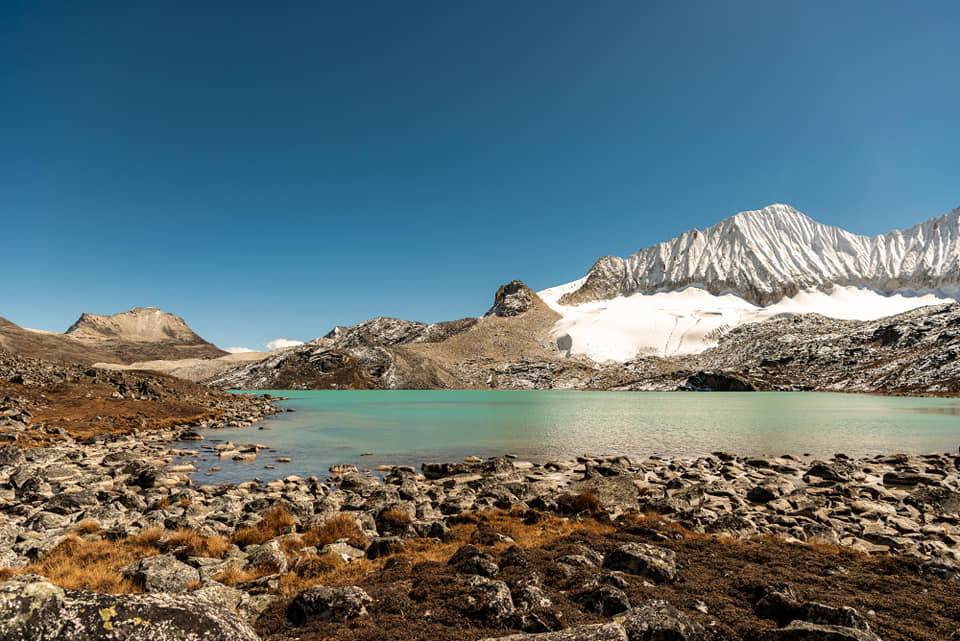Day 01: Arrive in Paro and transfer to Thimphu
- Altitude in Thimphu: 2,400m
- Distance: 55km
- Estimated travel time: 1,30hrs
Welcome to Bhutan! Let’s begin your amazing 18-day journey in the Land of Thunder Dragon!
Your plane will land at Paro International Airport (2,300m). The Himalayan mountains dominate Bhutan’s landscape, thus from the plane, you’ll be able to admire the breathtaking scenery of mountain peaks covered by blankets of snow. On good days, the snow blanket glisters under the sunlight, making it a sight to behold for lucky visitors!
As soon as you walk out of the Arrival Gate, you will see our representative waiting for you. You will be escorted to Thimphu – Bhutan’s enchanting capital.
The highway from Paro leading to Thimphu follows the Pachu River. And at the river confluence at Chuzum, we will pay a visit to Tachogang Lhakhang (Temple of The Excellent Horse). This is one of the most iconic works of Thangtong Gyalpo (1385-1464), a revered saint in Bhutanese culture. Visitors often enjoy walking along the iron bridge – also the temple’s iconic feature, festooned with colourful prayer flags. See the temple and spend some time appreciating the quaint surrounding with the clear river and verdant bushes.
Drive a bit more from Tachogang Lhakhang and we will be at Thimphu. In 1961, Thimphu became the capital of Bhutan. It is the largest city in Bhutan, home to over 115,000 people. While the city is now seeing development in particular parts, the juxtaposition of modernity and tradition offers visitors an interesting experience. The town is set in the hills of Thimphu valley, and stands right next to the great Thimphu Chhu.
After arriving in Thimphu, check in and we will head to one of the most visible landmarks in the capital – the National Memorial Chorten. It can be recognised from afar for its unique structure and has become a place of daily worship for the Bhutanese. The striking whitewashed chorten with golden finial was originally built by the Third King, Jigme Dorji Wangchuck to pray for world peace. The chorten later serves as a memorial to the Third King.
Learning about Bhutanese heritage and arts is the best way to complete your exploration of this kingdom. Through hundreds of years, Bhutanese traditions have been well-preserved by the locals and by the government. To gain an insight into the local heritage, we will tour the Folk Heritage Museum and the National Textile Museum. The heritage museum was constructed as a rural house from the mid-19th century with rammed mud timber and household objects, allowing visitors to best imagine people’s life back at the time. You will then see the practice of thagzo – Bhutan’s art of weaving using different styles and materials at the National Textile Museum.
Later, we will make our way to the National Institute for Zorig Chusum. Opened by the government, the institute plays an integral role in the preservation and promotion of the traditional arts and crafts of Bhutan. The locals call it the ‘Arts And Crafts School’ or the ‘Painting School’, and students learn traditional arts of Bhutan here. From embroidery, painting to statue-making and more, visitors will definitely be impressed with the skills and disciplines of the students at such a young age. There is a gallery where you can see more of the students’ works.
The rest of the day will be for you to acclimate and we will stay the first night at the hotel in Thimphu.
Day 02: Thimphu sightseeing
Start the day with a visit to Cheri Goemba, this place is one of the first Bhutan’s Buddhist monasteries. The hike to the goemba is a popular one with pretty scenery – thick forests of firs, rhododendron trees and blue pines. We will walk for 1 hour to reach Cheri Goemba, the elevation gain is 400m. The goemba, whose surroundings provide a tranquil and beautiful environment for the Buddhists, is perfect for meditating. From the building, you will be rewarded with the breathtaking view of the clear river and pristine forests below.
Next, we will continue to Buddha Point (Buddha Dordenma Statue). This is the tallest statue in the kingdom – 51,5m, so you can see it from quite far before reaching the actual site. Walking inside, you will find 125,000 smaller Buddha statues, all made of bronze and gilded in gold.
Tashichho Dzong is a must-visit site for any travelers to Thimphu. It is a striking construction which stands on the bank of the river. First built in 1216 A.D, the complex has a long history, consisting times of being damaged by fire and rebuilt, before being renovated by King Jigme Dorji Wangchuck when he moved the capital to Thimphu. Today, it houses the Bhutanese government.
The rest of your first day will be for city exploration. Thimphu is a charming city, bustling with shops, bazaars, and hospitality locals. You will see that everyone wears their Bhutanese traditional dress, this is a way to preserve the country’s culture. Ask your guide or find your way around for places with tasty local dishes, good music, and cool bars.
We will stay for another night at our hotel in Thimphu.
Day 03: Thimphu to Punakha
- Altitude in Punakha: 1,300m
- Distance: 75km
- Estimated travel time: 3hrs
Boost yourself with a tasty breakfast then we will drive to Punakha – the former capital of Bhutan. On our way, we will stop to enjoy the panoramic view of the eastern Himalayas from Dochula Pass (3,050m). Today, the pass is a popular destination with travelers to Bhutan. There is nothing that can quite compare to the feeling of standing from Dochula Pass and looking out to see the magnificent scenery. Not only the stunning view, you can also see 108 “Druk Wangyal Chortens” built to commemorate the soldiers who died in the war against insurgents from India. Opposite the chortens is the Druk Wangyal Lhakhang with beautiful wall carvings and paintings inside.
Once in Punakha, check in the hotel, followed by a short break and we will begin exploring this city’s attractions. We will do a short hike to Chimi Lhakhang (Temple of Fertility). Ascending only 20m, which may take 30 minutes, we will cross hillock fields to reach the temple that stands at an altitude of 1,500m. The temple is specially popular with women who wish to have children and those who just have newborns, they believe and come here to receive blessings. Don’t worry if you come here without looking for fertility or blessings, you are still welcome here. This is still a nice experience which lets you learn more about the Bhutanese culture.
Similar to Tashichho Dzong, Punakha Dzong, or the ‘Place of Great Happiness’ is one of the sites that should not be missed. Regarded as one of the most spectacular dzongs in Bhutan, this landmark has witnessed some of the most important moments in the history of Bhutan. Punakha Dzong offers a great view of the Pho Chhu and Mo Chhu, since it stands right at the confluence of the 2 rivers.
Not far from Punakha Dzong, we will head to Pho Chhu Suspension Bridge. With 160m in length, it is the longest suspension bridge in Bhutan. From the bridge, we can enjoy the wonderful sight of Punakha Dzong and Pho Chhu Valley.
We will spend the night at the hotel in Punakha.
Day 04: Punakha to Gangtey
- Altitude in Gangtey: 2,900m
- Distance: 87km
- Estimated travel time: 3hrs
The cool air in the morning will be ideal for a hike to Khamsum Yuelley Namgyal Chorten (1,500m). The chorten perches on a ridge above the Punakha Valley. We will cross the suspension bridge, then ascend 200m up the hill. The hike will be 1 hour, and despite the trail being a bit muddy, it’s an easy walk. Khamsum Yuelley Namgyal Chorten is one of Bhutan’s finest architectural examples, yet it is the only one of its kind in the world. It is nothing similar to other striking sites you come through in Bhutan. The building is a pagoda-style stupa with 4 stories, and various smaller pagodas surrounding it.
Later, join a famous and pleasant hike – the Gangtey Nature Trail. It is a popular walk, especially for travelers to discover the scenery of Gangtey valley. From the small hilltop overlooking Gangtey Goemba, the trail will descend to beautiful meadows then to Semchubara village. After the village, the thick forest of blue pines will welcome us. You will certainly enjoy the feeling of being close with nature, listening to the small sounds from the inhabitants of the forest. Continue and we will soon arrive at a valley viewpoint. The walk will finish once we see Khewang Lhakhang (Khewang temple).
Located near to the Khewang Lhakhang is the Black–necked Crane Visitor Centre. You can learn more about the endangered animal here, and other information regarding flora and fauna, community life and culture of the valley at the centre. It is also a great location to spot the Black-necked Cranes and other bird species in the valley.
The last site to check out today will be Gangtey Goemba. When erected in 1613, it was the only Nyingmapa monastery in the Black Mountain region, and today it remains the largest Nyingmapa monastery in the western land. From the impressive building, you will have the breathtaking views of Gangtey valley with stretches of green fields, untouched forests and great mountains.
Tonight, we will stay at the hotel in Gangtey.
Day 05: Gangtey to Bumthang
- Altitude in Bumthang: 2,800m
- Distance: 158km
- Estimated travel time: 6hrs
Say goodbye to the fairytale-like meadows and forests of Gangtey, we will travel to Bumthang. Bumthang comprises of four smaller valleys namely Tang, Ura, Choekhor and Chumey. Coming to the region, you will see some of the oldest palaces, Buddhist temples and monasteries in the entire kingdom. And each of them will wow you with intriguing history and astounding architecture!
The drive today will be quite long. Trongsa lies between Gangtey and Bumthang, and it also owns some famous attractions. So, there is no reason to miss out on a chance to discover Trongsa. We will take you to a number of attractions to tell you more about this city. In the late afternoon, we will arrive in Bumthang.
The first place to explore will be the historic Ta Dzong, the famous watchtower which once guarded Trongsa Dzong from internal rebellion. After that, it now serves as the National Museum with impressively large collections dedicated to the Wangchuck Dysnasty. Visitors can gain an insight of the kingdom’s history from the collections. The information is very well presented and the items are quite diverse, you can see from ancient relics to statues of deities.
Continue and visit Trongsa Dzong. The building has a strategic location, sitting high above the roaring Mangde Chhu river. Completed in 1644, the complex is considered the most spectacular dzong in Bhutan, and you may agree with that opinion even before arriving here. From afar, Trongsa Dzong catches the eye for its striking architecture with a sheer drop to the south that disappears behind the thick veils of clouds. The buildings trail down the ridge and are connected by a succession of alley-like corridors, with wide stone stairs. Between the buildings, you will come across lovely paved courtyards. Trongsa Dzong is so massive that it is easily visible from anywhere in town, thus remains a captivating sight to behold for visitors and locals.
In the afternoon, we will take a tour inside the Yathra Weaving Center. At the weaving center, you can understand more about the intriguing process of weaving yathras, the local’s unique woven textile with deep colors and mesmerizing designs. Besides, we will drive slowly and make stops for refreshments and sightseeing at certain spots.
We will stay at the hotel in Bumthang for the night.
Day 06: Discover Bumthang
Enjoy breakfast and then we will head to the famous Jambay Lhakhang, one of the sacred temples built by the 7th-century Tibetan king Songsten Gampo. The locals believe the king built the temples in only one day to subdue a demoness from Tibet, and Jambay Lhakhang was to pin down her left knee. The ancient temple was later visited by Guru Rinpoche and renovated by the Sindhu Raja after the Guru restored his life force.
Next, visit the imposing and important temple complex Kurjey Lhakhang. The sacred site is where the body (kur) print (jey) of Guru Rinpoche is preserved, located in a cave in the oldest of the three buildings of the complex.
We will then see the holy water at Kurjey Drupchu, located near Kurjey Temple. Kurjey Drupchu is believed to have been blessed by Guru Rinpoche himself.
From Kurjey Drupchu, we will have the option of driving or walking to Tamshing monastery. The walk will be around 1 hour, but we recommend this option if you would like to sightsee. The building, formally called Tamshing Lhendup Chholing (Temple of the Good Message), is the most important Nyingma goemba in Bhutan. Established in 1501 by the great spiritual master Pema Lingpa, the site was privately owned by his descendants until 1960. The unusual structure of the building was erected by Pema Lingpa himself, with the help of khandromas, who made many of the statues.
In the afternoon, we visit Mebar Tsho (The Flaming Lake), one of the most sacred sites in the country. The lake has its name following a legend that Pema Lingpa had dreamed of the treasure hidden by Guru Rinpoche in the lake. So, with a lamp in his hand, he dived into the water, retrieved the treasure and submerged it from the lake, while the lamp was still alighted. When coming here, devout Bhutanese always send a little lamp floating on the water and make a wish.
We will stay another night at the hotel in Bumthang.
Day 7: Dhur – Gorsum
- Distance: 18km
- Estimated time: 6-7hrs
- Ascent: 380m
- Camp altitude: 3,120m
Today we will head to Dhur. This is where the Dhur Hot Spring trek will start!
The trail from Bumthang to Gorsum is a gradual hike. From Dhur, the route will head north, following the valley of the Yoleng Chhu (also known as Gorzam Chhu), which is famous for its trout population. We will follow the river Gozzam Chhu on easy flat ground, travelling north for the most of the day.
En route, we will cross Lurawa Goemba. Our campsite for the day will be at Gorsum at 3,120m. For those who want to push ahead, there is an alternate site about three hours ahead.
Day 8: Gorsum – Lungsum
- Distance: 12km
- Estimated time: 5-6hrs
- Ascent: 40m
- Camp altitude: 3,160m
Wake up early to admire the amazing sunrise from your campsite. The sight of the sun slowly rising up above the snowcapped Himalayan peaks is always mesmerizing to look at. The moment alone will make you get rid of all the sleepiness!
After breakfast, we will get back on track. We will walk through a thick forest of spruce, hemlock, cypress, juniper and maple. Depending on the weather, the trail may be muddy. And on the way, you may meet some Bhutanese wild dogs so keep your cameras ready. The trail will ascend gradually to the campsite at Lungsum (3,160m). The campsite is set in a meadow and we will stay here tonight.
Day 9: Lungsum – Tshochenchen
- Distance: 15km
- Estimated time: 6-7hrs
- Ascent: 620m
- Camp altitude: 3,900m
Today’s trek remains more or less the same as yesterday’s, we will be passing through similar terrain and flora. Soon on the trek you will notice that there are a large number of yaks. Moreover, this trail has a typical feature with stones wrapped by rhododendron leaves. These are the works of herders, placed around to protect their yaks.
Along the way, we will come across a bifurcation; from here, the trail to the right leads to Gangkhar Puensum via Thole La, and the left trail leads to the springs. We will walk over a steep ridge before arriving at a scenic alpine valley, then the trail will flatten out. Towards the end of today’s hike, the vegetation begins to thin out. We will continue until arriving at the camp in Tsochenchen, located at 3,780m above sea level.
Day 10: Tshochenchen – Dhur Tsachu
- Distance: 18km
- Estimated time: 8-9hrs
- Ascent: 1,340m, descent: 1,530m
- Camp altitude: 3,590m
The exciting part of the Tshochenchen – Dhur Tsachu trail is that we will have a chance to see Mount Gangkhar Puensum.
From Tshochenchen, trek through wildflower meadows, go uphill all the way until we reach Djule La (4,700m), a rocky saddle with some prayer flags. There are not only prayer flags here, but also a number of cairns, making it an interesting sight at the pass. If the weather is good with a clear sky, we will have a great view of the surrounding mountains from the pass, including the great Mount Gangkhar Puensum. This is the highest mountain in Bhutan and also the highest unclimbed peak, with an elevation of 7,570m.
After crossing the pass, the trail will descend to Djule Tsho at 4,220m, then hike again to Gokthong La (4,640m). From here, we will follow a steep descent through a thick jungle until we are at the campsite near Dhur hot springs at 3,590m. Along the way, you may come across the sight of musk deer, herds of blue sheep and Himalayan bears.
Day 11: Dhur Tsachu
Spend the entire day resting at Dhur Tsachu! This will be the highlight of our whole trip. You can enjoy a late breakfast, chill out in the rejuvenating hot springs or take a leisurely hike around nearby areas.
Hot Spring therapy is a popular practice in many countries, especially the Asian ones, and it is the same in Bhutan. According to the Institute of Traditional Medicinal Services, the Dhur hot springs water contains coal, limestone, and sulfur. Thanks to the dissolved minerals in the water, the hot springs water has significant healing properties to one’s mind and body. A session at Dhur Hot Springs may help with your headaches, joint pains, and improve your blood flow after days of trekking. Enjoying the serene natural surroundings of the hot springs will also ease your mind and let you feel the healing energy running through your body.
For Bhutanese, they believe that the hot springs have originated from the blessings of Lord Buddha and Bodhisattvas, because their sources are located in sacred sites!
Day 12: Dhur Tsachu – Tshochenchen
- Distance: 18km
- Estimated time: 8-9hrs
- Ascent: 1,530m, descent: 1,340m
- Camp altitude: 3,780m
We hope that after a day well relaxing in the hot water of Dhur Tsachu, you will feel energized on the way back. We will return by the same route on day 10. Thus, you can admire the sight of Mt. Gangkhar Puensum again.
Trek through the jungle and ascend to Gokthong La pass. Continue and we will come across Djule Tsho. We will walk all the way to Djule La pass and return to camp at Tshochenchen.
You may feel that today’s trek is tougher than before as there is slightly more hiking than descending.
Day 13: Tshochenchen – Lungsum
- Distance: 15km
- Estimated time: 5-6hrs
- Descent: 620m
- Camp altitude: 3,160m
Return by the route taken on day 9 to get back to Lungsum. From our camp, we will cross the scenic alpine valley and then descend to the ridge. You will see stones wrapped by rhododendron leaves one more time together with herds of yaks. We are certain that even after you have met these animals several times in Bhutan, their bulky frames with extremely long fur and handle bar horns are still interesting to observe.
Before getting to Lungsum, walk through green meadows. If you travel during spring, these meadows will be full of wildflowers. For photography-lovers, take out your cameras and you may have wonderful photos of flowers, verdant plants and mountains in the background. These will be for you to look back when you miss this amazing country.
We will stay overnight at the campsite.
Day 14: Lungsum – Gorsum
- Distance: 12km
- Estimated time: 4hrs
- Descent: 40m
- Camp altitude: 3,120m
The trail will descend gradually from the campsite. Continue hiking and we will soon walk-through a dense forest of spruce, hemlock, cypress, juniper and maple. After the forest, the picturesque meadow where Gorsum campsite is set will welcome us back. At the end of the day, you can spend time simply breathing in the fresh air and watching the gorgeous sunset in the distance.
Tonight, we will camp in Gorsum again.
Day 15: Gorsum – Dhur Village – Bumthang
- Distance: 18km
- Estimated time: 6hrs
- Descent: 380m
The schedule for this day will be mostly driving. From Gorsum, we will go downhill gradually until the bridge near Dhur village, where we reach the road head. Here our car will be waiting at the trek’s endpoint to take us to the hotel in Bumthang.
Stay overnight in the town and this will be our last night in Bumthang.
Day 16: Bumthang to Paro
Today, we will fly back to Paro on a short 35-minute flight.
Later, we will discover the outstanding Paro Rinpung Dzong (Fortress of The Heap of Jewels), a marvelous example of Bhutanese architecture with a complex of courtyards, temples, offices and accommodating area behind towering walls. The edifice sits on a steep hillside, offering terrific views of Paro valley. And no matter where you are in Paro valley, you can always see the dzong.
The next dzong will be just as appealing as the previous one – the National Museum of Bhutan. This was once called Ta Dzong, with a prime position on top of the hill overlooking Paro Dzong. Thus, it offers visitors a breathtaking view of the valley. Turned into a museum in 1968, Ta Dzong’s collection has a large number of antique thangka paintings, weapons and armor, and a rich diversity of natural and historic artifacts.
Kyichu Lhakhang, one of the oldest and most sacred temples in the country, will be the next site to visit. It is believed that the Tibetan King Songtsen Gampo had built 108 temples around the Himalayas in the 7th century to defeat a powerful ogress, and Kyichu Lhakhang was one of them. The main relic includes a statue of future Buddha Jowo Jampa (Maitreya) and a statue of Buddha Sakyamuni.
After returning to the town, you can opt for wandering around and visiting the cool pubs and some shops in the area. The town provides fun nightlife for travelers with amazing live music and mouth-watering snacks and local alcohol for one to try out.
Tonight, we will stay at the hotel in Paro.
Day 17: Paro sightseeing
Paro is where your journey starts, and Paro will also be where it ends.
In the morning, we will have breakfast then begin the hike to Taktsang Monastery. This is one of the most venerated places of pilgrimage for Bhutanese. There is a saying that “If you haven’t visited Taktsang Monastery, your trip to Bhutan is not completed”. The name Taktsang means Tiger’s Lair, and the entire site perches on a cliff 2,950m above the sea level. And visiting the sacred place will be one of the most unforgettable experiences of your trip.
The hike to the monastery will take 4-5 hours. The trail is 4,5km one way, and has an elevation gain of 900m. We will start the trip early in the morning, and throughout the hike, there will be breaks for you to enjoy the incredible views of Paro’s pristine landscape, from the emerald green valleys to the snow-clad Himalayan peaks.
Once we are there, you will have some time to explore the monastery. Buildings are connected to each other by staircases with steps carved into the rock and they also offer an astonishing view of the valley. You can walk around to admire the luxurious interior design with gold-plated dome and golden god and deity statues.
Later, head back to the main town and we will have a special meal with a local family. This is a good opportunity to make new friends with the locals while tasting the authentic and delicious Bhutanese dishes. You will have dishes of Ema Dashi, red rice, Jasha Maru, or Phaksha Paa, all are Bhutanese signature food.
We will sleep in Paro for the last night.
Day 18: Depart Paro
Time to bid farewell to Paro and the beautiful country Bhutan. It is our honour to know that along the way, you have made some of the most unforgettable memories with the help of our guide and driver. And we look forward to welcoming you back to our country one day. Tashi Delek!
